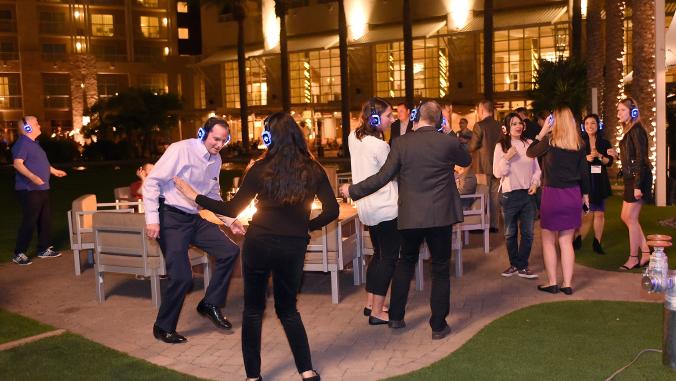How Etsy crafted its biophilic headquarters
The company found that working with nature's principles can attract workers who feel engaged, happier and more creative.

Etsy, the online marketplace for handmade goods, is known as an antidote to mass-made home furnishings, clothing and gifts. The quirky company experienced major-league growth after it went public in 2016, posting nearly $82 million in revenue in its first quarter with a 19 percent jump in stock price.
The company is determined to help itself, its community and the people affected by its supply chain flower to the fullest potential. So when the time came to move some 800 employees to a new location, Etsy undertook one of its biggest creative challenges yet: working with the International Living Future Institute’s Living Building Challenge (LBC) to earn the sought-after "petal" certification.
The Challenge comprises seven performance categories, or petals: place; water; energy; health and happiness; materials; equity; and beauty. Each category is rigorously designed to satisfy the requirements of a "living" building that has a regenerative impact on its natural and social environment. That includes eschewing toxic materials and leaving net-zero impact on energy use and water. Regenerative buildings must look beautiful and make their workers happy, too.
On a recent tour through Etsy’s new 200,000 square-foot headquarters in Brooklyn’s cobblestoned Dumbo neighborhood, a guide said the living building philosophy has a positive impact on employees, who strive for creativity. She said the artisanship that went into building the space makes employees feel more capable. And by keeping people healthy, happy and engaged in their work, they tend to stay longer at the company and be more productive.
The Challenge is comprised of seven performance categories, or petals: place; water; energy; health and happiness; materials; equity; and beauty.
Greener pastures for the mind
Underlying incentives fuel the demand for greener buildings. Operating costs for buildings with efficient heating, air conditioning, plumbing and other key technologies decreased by 13.6 percent over five years for new construction. According to the U.S. Green Building Council (USGBC), annual utilities per employee in green facilities dropped by $675.26.

Most important are the benefits to humans of biophilic buildings, which weave a connection between nature and man-made environments. Office workers in spaces that mimic the environment in ways like having large outdoor windows and natural light have an average of 16 percent higher productivity than those working in non-green firms — and they perform 10 to 25 percent better on tests of mental function and memory recall, as the USGBC cited.
A global Yale survey of 3,700 students from the 29 top-ranked business schools showed that most believe environmental action will improve economic growth and new jobs. Twenty percent of these students said they would even point-blank refuse job offers from companies with poor sustainability records. Evidence also shows that millennial workers are most attracted to environments that have an environmental edge or serve a societal purpose.
"Equity is important on issues of social justice, materials selection and the supply chain," said James Connelly, director of the International Living Future Institute’s Living Product Challenge. "Beauty is important because unless the space is beautiful and cared for, it’s not truly going to last and be sustainable. Younger workers want to have a connection to the values of the company they are working for."
Because each company’s environment and footprint differs, there is no one-size-fits all approach to designing a regenerative building. You might say it has to grow organically, which is where the Living Building Challenge comes in to uproot what we think a workplace can be.
Each company’s environment and footprint is different, so there is no one-size-fits all approach to designing a regenerative building.
An artisanal approach
Etsy is working on earning full LBC certification in 2017. Only eight buildings in the world have this stamp, with hundreds more in the certification process. But Etsy's building already has the beauty and materials aspects covered (as well as beauty, health and happiness petals), as verdant plants climbing up the hallways show.
These inner gardens are fed by roof-collected rainwater that courses down through an in-house irrigation system, helping to reduce surrounding storm runoff. This fits the LBC's water petal, which states that projects must work in harmony with the natural water flows of a site without waste or chemical treatments.

Etsy has helped create an online world that relates to consumerism in a way that respects the "maker"; similarly, living buildings realign how people relate to the natural environment and their workspaces.
"Initially, there was a good alignment of values between the Living Building Challenge and Etsy’s values," said Connelly. "We wanted to push as far as we can to achieve an aspirational goal instead of achieving a checklist of metrics."
The project planning phase between the Institute and Etsy lasted three years, during which the company surveyed employees about their needs and desires.
"Immediately, we recognized the goals it had: Create a space primarily using furniture and art and other installations made from local manufacturers," said James. "We are forging a new path for thinking how to do commercial office design, understand what Etsy’s needs are for the space, meet environmental attributes and use small makers."
Work-life balance, reimagined
The LBC process encourages designers and owners to work together from the start to ensure that purpose, sustainability and artisanship each play an integral role in the finished building. Thus, all of the wood within the Etsy office was made from reclaimed sources or from Forest Stewardship Council-approved sources. Some of the scaffolding even came from old New York City water towers.
Etsy’s greatest strength is its ability to bring together top do-it-yourself talent. Naturally, the company cultivated the LBC’s materials petal by scouting local designers to functionally decorate its home base. Half of the office's furnishings were handcrafted by local Etsy sellers who conformed to strict standards that prevent deforestation and the use of dangerous Red List chemicals.

Oak, steel and concrete are the designer’s favorite materials. In the middle of New York City’s concrete jungle, reclaimed wood, solar panels, indoor gardens and unique designs mix to create harmony in the Etsy workplace.





